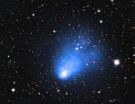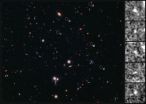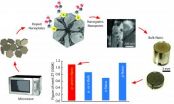(Press-News.org) An extremely hot, massive young galaxy cluster — the largest ever seen in the distant Universe — has been studied by an international team using ESO's Very Large Telescope (VLT) in the Atacama Desert in Chile along with NASA's Chandra X-ray Observatory and the Atacama Cosmology Telescope. The new results are being announced on 10 January 2012 at the 219th meeting of the American Astronomical Society in Austin, Texas.
The newly discovered galaxy cluster [1] has been nicknamed El Gordo — the "big" or "fat one" in Spanish. It consists of two separate galaxy subclusters colliding at several million kilometres per hour, and is so far away that its light has travelled for seven billion years to reach the Earth.
"This cluster is the most massive, the hottest, and gives off the most X-rays of any cluster found so far at this distance or beyond," said Felipe Menanteau of Rutgers University, who led the study. "We devoted a lot of our observing time to El Gordo, and I'm glad our bet paid off and we found an amazing cluster collision."
Clusters of galaxies are the largest objects in the Universe held together by gravity. The process of their formation, when smaller groups of galaxies merge together, very much depends on the amount of dark matter and dark energy in the Universe at that time — so studying clusters can shed some light on these mysterious components of the cosmos.
"Gigantic galaxy clusters like this one are just what we were aiming to find," said team member Jack Hughes, also of Rutgers. "We want to see if we understand how these extreme objects form, using the best models of cosmology that are currently available."
The team, led by Chilean and Rutgers astronomers, found El Gordo by detecting a distortion of the cosmic microwave background radiation. This faint glow is the remnant of the first light from the Big Bang, the extremely hot and dense origin of the Universe about 13.7 billion years ago. This radiation left over from the Big Bang interacts with electrons in the hot gas in galaxy clusters, distorting the appearance of the background glow seen from Earth [2]. The denser and bigger the cluster, the bigger this effect. El Gordo was picked up in a survey of the microwave background with the Atacama Cosmology Telescope [3].
ESO's Very Large Telescope was used by the team to measure the velocities of the galaxies in this huge cluster collision and also to measure its distance from Earth. In addition NASA's Chandra X-ray Observatory was used to study the hot gas in the cluster.
Although a cluster of El Gordo's size and distance is very rare, the authors say that the new results are still consistent with astronomers' current understanding of a Universe that started with a Big Bang and is mostly made of dark matter and dark energy.
El Gordo most probably formed just like the Bullet Cluster (http://chandra.harvard.edu/photo/2006/1e0657/), a spectacular interacting cluster of galaxies that is almost four billion light-years closer to Earth. In both clusters there is evidence that normal matter, mainly composed of hot, X-ray-bright gas, has been wrenched apart from the dark matter. The hot gas was slowed down by the collision, but the dark matter was not.
"This is the first time we've found a system like the Bullet Cluster at such a large distance," said Cristóbal Sifón, student at the Pontificia Universidad Católica de Chile (PUC) in Santiago. "It's like the old saying: If you want to understand where you're going, you have to know where you've been."
INFORMATION:
Notes
[1] The formal name of the cluster is ACT-CL J0102-4915, the first part of the name shows that it is a galaxy cluster found using data from the Atacama Cosmology Telescope and the second part indicates the location of the object on the sky, in the southern constellation of Phoenix.
[2] The effect is called the Sunyaev–Zel'dovich (SZ) effect after the Russian astronomers, Rashid Sunyaev and Yakov Zel'dovich who predicted it in the late 1960s.
[3] The Atacama Cosmology Telescope (ACT) is a six-metre telescope on Cerro Toco in the Atacama Desert in the north of Chile and close to the site of ALMA. It is designed to make high-resolution surveys of the microwave sky to study the cosmic microwave background radiation.
More information
These results on El Gordo are being announced on 10 January 2012 at the 219th meeting of the American Astronomical Society in Austin, Texas. A paper, "The Atacama Cosmology Telescope: ACT-CL J0102−4915 'El Gordo', A Massive Merging Cluster at Redshift 0.87" by Felipe Menanteau et al, describing these results has been accepted for publication in The Astrophysical Journal.
The team consists of: Felipe Menanteau (Rutgers University, USA), John P. Hughes (Rutgers), Crisóbal Sifón (Pontificia Universidad Católica de Chile [PUC]), Matt Hilton (University of Nottingham, UK), Jorge González (PUC), Leopoldo Infante (PUC), L. Felipe Barrientos (PUC) , Andrew J. Baker (Rutgers) , Sudeep Das (University of California, Berkeley, USA; Princeton University, USA), Mark J. Devlin (University of Pennsylvania, USA), Joanna Dunkley (Oxford University, UK) , Adam D. Hincks (Princeton University), Arthur Kosowsky (University of Pittsburgh, USA) , Danica Mardsen (University of Pennsylvania), Tobias A. Marriage (The Johns Hopkins University, Baltimore, USA) , Kavilan Moodley (University of KwaZulu-Natal, Durban, South Africa), Michael D. Niemack (NIST, Boulder, USA) , Lyman A. Page (Princeton University) , Erik D. Reese (University of Pennsylvania) , Neelima Sehgal (Stanford University, USA), Jon Sievers (University of Toronto, Canada) , David N. Spergel (Princeton University), Suzanne T. Staggs (Princeton University) and Edward Wollack (Goddard Space Flight Center, USA).
The year 2012 marks the 50th anniversary of the founding of the European Southern Observatory (ESO). ESO is the foremost intergovernmental astronomy organisation in Europe and the world's most productive astronomical observatory. It is supported by 15 countries: Austria, Belgium, Brazil, the Czech Republic, Denmark, France, Finland, Germany, Italy, the Netherlands, Portugal, Spain, Sweden, Switzerland and the United Kingdom. ESO carries out an ambitious programme focused on the design, construction and operation of powerful ground-based observing facilities enabling astronomers to make important scientific discoveries. ESO also plays a leading role in promoting and organising cooperation in astronomical research. ESO operates three unique world-class observing sites in Chile: La Silla, Paranal and Chajnantor. At Paranal, ESO operates the Very Large Telescope, the world's most advanced visible-light astronomical observatory and two survey telescopes. VISTA works in the infrared and is the world's largest survey telescope and the VLT Survey Telescope is the largest telescope designed to exclusively survey the skies in visible light. ESO is the European partner of a revolutionary astronomical telescope ALMA, the largest astronomical project in existence. ESO is currently planning a 40-metre-class European Extremely Large optical/near-infrared Telescope, the E-ELT, which will become "the world's biggest eye on the sky".
Links
Link to preprint of the science paper: http://arxiv.org/abs/1109.0953
Images of VLT at the Paranal Observatory: http://www.eso.org/public/images/archive/category/paranal/
Information about NASA's Chandra observatory: http://www.nasa.gov/chandra
Further information about the Atacama Cosmology Telescope: http://physics.princeton.edu/act/about.html
Contacts
Felipe Menanteau
Rutgers University
Piscataway, New Jersey, USA
Tel: +1 732 445 5500 (x7433)
Email: felipe@physics.rutgers.edu
John P. Hughes
Rutgers University
Piscataway, New Jersey, USA
Cell: +1 732 445 5500 x 0980
Email: jph@physics.rutgers.edu
Cristóbal Sifón
Pontificia Universidad Católica de Chile
Santiago, Chile
Tel: +56 2 354 4940
Email: cjsifon@astro.puc.cl
Richard Hook
ESO, La Silla, Paranal, E-ELT and Survey Telescopes Public Information Officer
Garching bei München, Germany
Tel: +49 89 3200 6655
Cell: +49 151 1537 3591
Email: rhook@eso.org
Megan Watzke
Chandra X-ray Center
Cambridge, Massachusetts, USA
Tel: +1 617-496-7998
Email: mwatzke@cfa.harvard.edu
El Gordo -- a 'fat' distant galaxy cluster
2012-01-11
ELSE PRESS RELEASES FROM THIS DATE:
Long Island Exchange Columnist Cognac Wellerlane Interviews Celebrities at The House of Savoia
2012-01-11
Over the holidays Long Island Exchange Columnist Cognac Wellerlane attended a holiday celebration at the House of Savoia. The event was hosted by suit and costume designer Michelle Savoia and Vanity Fair editor George Wayne. It was held on Essex Street in the lower east side of Manhattan.
The House of Savoia is known for its custom suits and men's apparel and Savoia is famous for designing costumes for Broadway shows. The event was sponsored by Van Gogh Vodka, and cocktail courtesy by Molinari. Among those who attended were a variety of celebrities, such as models, actors, ...
HCMWorks Managing Partner Named to Sourcing Interest Group (SIG) Advisory Board
2012-01-11
HCMWorks announced today the naming of Ted Weyn to the Sourcing Interests Group's Advisory Board.
Sourcing Interests Group (SIG), www.sig.org, is a membership organization comprised of sourcing and outsourcing professionals from Fortune 500 and Global 1000 companies, as well as the service providers and advisory firms that serve them. Members of all types are focused on advancing the sourcing/procurement and outsourcing industries by sharing best practices and thought leadership in a strictly-enforced non-commercial environment.
SIG is acknowledged globally for its ...
New findings by St. Michael's researchers about the way cells work
2012-01-11
New findings by St. Michael's researchers about the way cells work could lead to a test and therapy for kidney failure caused by E. coli
TORONTO, Ont., Jan. 10, 2012—Ever since the water supply in Walkerton, Ont., was contaminated by E. coli in 2000, Dr. Philip Marsden has been trying to figure out just how a toxin released by that particular strain of the bacteria causes kidney damage in children.
Now Dr. Marsden and his team based at St. Michael's Hospital and the University of Toronto, led by graduate student Tania Petruzziello-Pellegrini, together with an international ...
Hubble pinpoints furthest protocluster of galaxies ever seen
2012-01-11
Using the NASA/ESA Hubble Space Telescope, astronomers have uncovered a cluster of galaxies in the initial stages of development, making it the most distant such grouping ever observed in the early Universe.
In a sky survey made in near-infrared light Hubble has spotted five galaxies clustered together. They are so distant that their light has taken 13.1 billion years to reach us. These galaxies are among the brightest galaxies at that early stage of the Universe's history. They are also very young: we are seeing them just 600 million years after the Universe's birth ...
Irish Tenor, Ronan Tynan, to Keynote Myotronics 46th Anniversary Seminar
2012-01-11
Myotronics, Inc is pleased to announce its 46th Anniversary Seminar in Seattle, June 29-30, 2012 will feature Ronan Tynan of the Irish Tenors. Known for his passion and determination in surmounting various challenges throughout his life, Mr. Tynan is an inspiring motivational speaker, an accomplished athlete, an orthopedic sports medicine physician, and a celebrated tenor. Mr. Tynan will deliver the Keynote address, before the program of 20 leaders in the field of neuromuscular dentistry begins.
The seminar schedule is designed to allow participants to select the presentations ...
Yachting Exclusive: December Yachting Round Up
2012-01-11
Despite the recent good weather in the Mediterranean, which has seen an unseasonal extension of the summer luxury yacht charter season, every good thing must come to an end and as we move into 2012 the focus of the luxury yacht charter market inevitably moves west to Florida and the Caribbean. Unfortunately the good weather clearly did not manage the move west and the Fort Lauderdale International Boat Show, which took place between the 28th and 31st of October, was hit by stormy wet weather that had an inevitably negative effect on attendance.
As we approach the winter ...
The path less traveled: Research is driving solutions to improve unpaved roads
2012-01-11
MANHATTAN, KAN. -- A Kansas State University graduate student sees the unpaved road ahead, and it's filled with biomaterial.
Wilson Smith, master's student in civil engineering, Independence, Mo., is working with lignin, a plant-based sustainable material that can be added to improve the quality of unpaved roads throughout Kansas.
More than 70 percent of the 98,000 miles of roads in Kansas are unpaved, Smith said.
"One of the problems with unpaved roads is that they are made from loose granular soils with particles that are not bound to each other on the road surface," ...
Who's wealthy? Beyond net worth, asset and debt levels change our perceptions
2012-01-11
Will borrowing money to buy a new car make you feel richer? It depends on your net worth, says a new study in Psychological Science, a journal published by the Association for Psychological Science. "People's perceptions of wealth vary not only as a function of their net worth, but also of the amount of assets and debt they have," says Princeton University psychology graduate student Abigail B. Sussman, who wrote the study with Princeton professor Eldar Shafir. In fact, increasing your assets by taking on debt affects perceived wealth in opposite ways for people who are ...
Nature Materials: Quick-cooking nanomaterials in microwave to make tomorrow's air conditioners
2012-01-11
Troy, N.Y. – Engineering researchers at Rensselaer Polytechnic Institute have developed a new method for creating advanced nanomaterials that could lead to highly efficient refrigerators and cooling systems requiring no refrigerants and no moving parts. The key ingredients for this innovation are a dash of nanoscale sulfur and a normal, everyday microwave oven.
At the heart of these solid-state cooling systems are thermoelectric materials, which can convert electricity into a range of different temperatures—from hot to cold. Thermoelectric refrigerators employing these ...
Winter Holiday Car Hire in San Francisco and Orlando Booking Up Fast Reports eRentals.co.uk
2012-01-11
Car hire deals website eRentals.co.uk has this week warned UK tourists heading for the sunshine in the States this winter to get their skates on when booking car hire deals. The site, which is home to deals for more than 12,000 locations, has seen a recent surge in hire car bookings for Orlando and San Francisco airports.
San Francisco in California is a hugely popular holiday destination for UK tourists who want to enjoy a bit of sunshine in the winter time, and this January is seeing many travellers booking up cheap rental deals there. Right now eRentals.co.uk has ...




